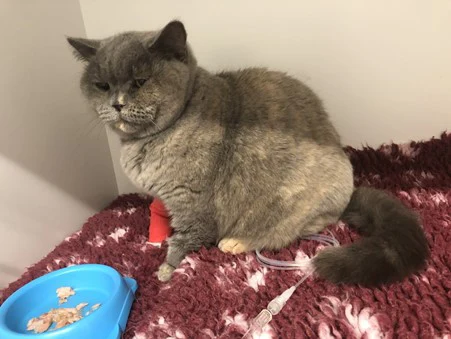Fluff was a 9-year-old female British Short Hair cat seen by the internal medicine team because she was suddenly a bit off colour, not eating well, lethargic and seemed to have lost some weight. A few days before presentation, she started vomiting and had some diarrhoea. She has no other known illnesses, and the other cat was fine. Fluff is an outdoor cat and up to date with her vaccinations and deworming treatments
The physical examination was unremarkable except:
- Body condition score of 3-4/9
- Mild dental calculus
- Generalised mild gingivitis
- A full blood examination showed a mild neutrophilia and eosinopenia
- On her biochemistry the GGT was mildly elevated with 11 (<4) and the SDMA was 18 (<14).
- On a gastrointestinal panel, fTLI was normal, Spec fPL was 11.3 ug/L (<3.5). Cobalamin (B-12) 294.0 ng/L 270.0 - 1000.0 and folate 8.4 ug/L (9.5 - 20.2)
- Full urine analysis including culture was unremarkable

The history, physical examination and these blood findings include already valuable information. First, the significant weight loss cannot be achieved with this short phase of reduced food intake only. A malabsorptive process was already considered. On bloods a mild elevation of GGT is suggestive for a cholestatic process. The folate was reduced, which is absorbed in the proximal small intestine only. Values below the control range are consistent with disease affecting the proximal small intestine. Cobalamin is below 400 ng/L, which is already suggestive for a deficiency on a cellular level, despite being in the reference range and absorbed in the distal small intestine (specifically in the ileum). Values below the control range are often seen in patients with EPI (ruled out with the normal fTLI), bacterial overgrowth in the upper small intestine, or disease affecting the distal small intestine. These are very important findings since it takes months to develop deficiencies of these essential vitamins.
Overall, a suspected pancreatopathy/possibly pancreatitis, generalised gastroenteropathy and possible cholangiohepatopathy were the working diagnoses at this stage, leading to the suspicion of feline triaditis.
As a next diagnostic step, an abdominal ultrasound was performed. Findings worth mentioning included a generalized prominent mucosa in the small intestine (despite normal wall thickness with multifocal hypomotile areas), an empty stomach with reduced layering focally at fundus but normal thickness and surrounded by a slightly more reactive mesentery. The pancreas was surrounded by a prominent hyperechogenic mesentery, the pancreas itself was quite unremarkable.
The lymph nodes were mildly enlarged up to 1.5cm and the liver was unremarkable. The gall bladder wall was smooth and thin, one septum was visible and a gravity dependent mild amount of hyperechogenic sediment could be observed. The kidneys had minor changes, suspected age/degenerative related.
Initially, a symptomatic treatment trial with antinausea, prokinetic medication, analgesia took place to which Fluff did respond quickly. However, over the next few days she did deteriorate again and an explorative laparotomy including surgical biopsies was performed, revealing a generalized moderate (lympho)plasmacytic (and mild neutrophilic) gastroenteritis with moderate to marked villus atrophy, low grade fibrosis and rare crypt abscesses. The lymph nodes had benign and reactive changes. In the liver mild to moderate hepatocellular vacuolar change could be detected.

The diagnosis was acute or chronic gastroenteritis, called inflammatory bowel disease (IBD). The cause of this pathology is largely unknown, but current evidence suggests that it arises from a complex abnormal interaction between the immune system, diet, bacterial populations in the intestines and other environmental and genetic factors.
Fluff was started on a prescription gastrointestinal diet, antibiotics and steroids. In addition, Vitamin B12 has been supplemented over 12 weeks. Over time her antibiotics could be stopped, and steroids have been gradually tapered down. In this process she gained weight, was much more active and had an excellent appetite. This did not change with the reduction in medication, and she has been a happy cat ever since.
